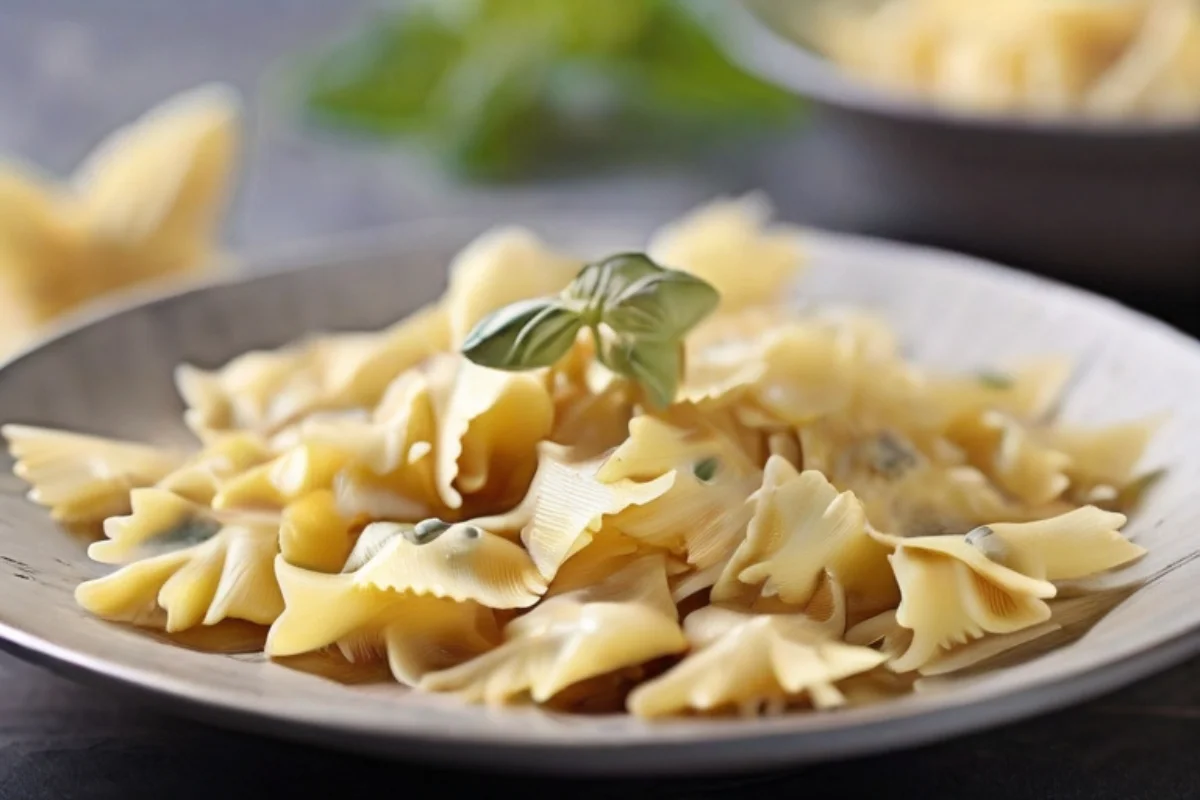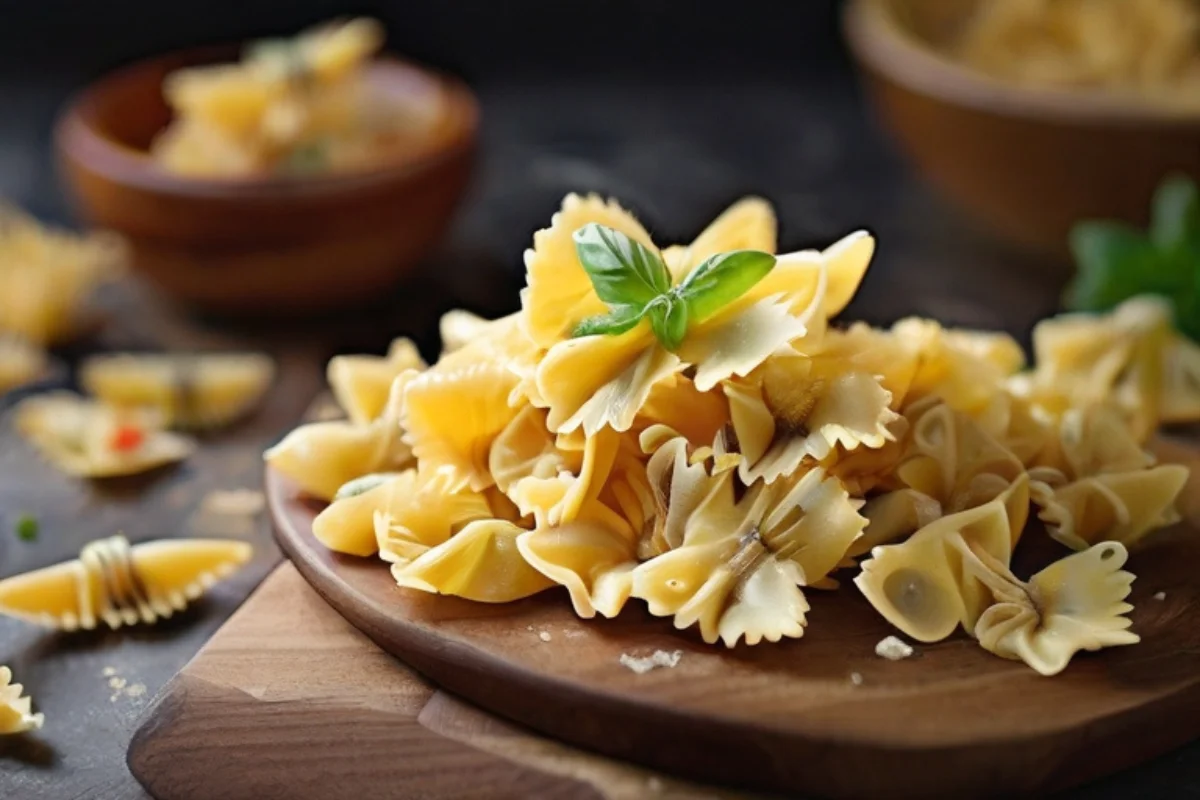Introduction to Farfalle Pasta
Overview of Farfalle Pasta
Farfalle, known as “bow-tie” or “butterfly” pasta, carries a rich history from the Emilia-Romagna and Lombardy regions of Italy. Its design, more than just visually appealing, helps grip delicious sauces, enriching every dish with a symphony of flavors. The name farfalle, Italian for butterflies, evokes images of lightness and elegance. This pasta’s making, dating back to the 16th century, showcases culinary artistry, requiring just a pinch, twist, and fold to create its unique shape.
Why It’s Called “Bow-tie” or “Butterfly” Pasta
The charm of farfalle comes from its whimsical shape, reminiscent of both a bow-tie and butterfly wings. This dual imagery has made it popular among adults and children, making it a versatile choice for various dishes. Whether tossed in vibrant pesto, paired with hearty meat sauce, or simply dressed in olive oil and Parmesan, farfalle makes every meal festive.
Moreover, farfalle’s shape does more than please the eye; it traps flavors and sauces, ensuring delicious bites. This unique feature sets farfalle apart, making it a favorite for chefs and home cooks alike.
In conclusion, farfalle pasta, rich in history and playful in shape, celebrates Italian cuisine’s joy. It reminds us that simple ingredients can transform into something magical. As we explore farfalle further, we appreciate the artistry and tradition in each piece, making every dish a flavor and creativity celebration.
Types and Varieties of Farfalle
Traditional Farfalle
At the heart of farfalle‘s appeal lies its traditional form. Craftsmen and home cooks shape this pasta by cutting dough into rectangles and pinching the centers. This simple yet elegant process yields the classic “bow-tie” or “butterfly” appearance. Traditional farfalle pairs wonderfully with a range of sauces, from light olive oil dressings to more robust meat-based sauces, showcasing its versatility in the kitchen.
Farfalle Rigate
A delightful twist on the classic, farfalle rigate introduces a textured edge to the pasta’s familiar shape. These ridges add not only a visual contrast but also a functional benefit. They enhance sauce adherence, making every forkful even more flavorful. Ideal for thicker, creamier sauces, farfalle rigate elevates traditional recipes with an added layer of texture and taste.
Colored Farfalle
A feast for the eyes, colored farfalle introduces a playful palette to the dinner table. Using natural ingredients like spinach, beetroot, and squid ink, artisans infuse the pasta with vibrant hues. These colorful variations not only add a visual pop to dishes but also hint at the flavors they embody. Perfect for special occasions or to brighten up a weeknight meal, colored farfalle turns any dish into a work of art.
Each type of farfalle, with its unique characteristics, invites us to explore the vast culinary landscape that pasta offers. Whether you’re drawn to the simplicity of the traditional, the texture of the rigate, or the vibrancy of colored varieties, farfalle pasta provides a canvas for creativity and flavor in every dish. As we continue to delve into the world of farfalle, let’s embrace the diversity and potential that these shapes bring to our tables.
Even Cooking with Farfalle
Cooking Tips for Perfect Farfalle
Cooking farfalle to perfection involves precision and care. Begin by bringing a large pot of salted water to a rolling boil. The salt isn’t just for flavor—it helps reduce stickiness by elevating the boiling point of the water. Aim for an al dente texture, which usually takes 8 to 10 minutes. Stir occasionally to ensure even cooking. For a deeper dive into cooking techniques, explore our guide on Mastering Pasta Cooking Techniques.
Selecting Sauces and Ingredients for Farfalle
Farfalle’s shape makes it ideal for clinging to sauces. For a light option, consider a basil pesto, which its grooves hold well. For heartier preferences, a Bolognese sauce enriches farfalle with its meaty depth. Incorporating seasonal vegetables or lean proteins can transform your farfalle dish into a balanced meal. Discover more about balancing flavors in our Ultimate Guide to Fusilli Sauce Pairings, applicable for farfalle as well.

Three Signature Farfalle Recipes
- Pesto Farfalle with Sun-dried Tomatoes and Pine Nuts: This dish is a testament to farfalle’s ability to marry well with pesto and tangy sun-dried tomatoes. Pine nuts add a delightful crunch, enhancing the texture.
- Creamy Salmon Farfalle: Here, farfalle serves as a canvas for creamy dill and lemon-infused salmon. It’s a harmonious blend of richness and refreshing zest.
- Farfalle Primavera: Embrace the bounty of spring with this vibrant vegetable pasta. Sauteed greens and seasonal veggies tossed with farfalle make a refreshing, colorful meal.
For more culinary inspiration and recipes that can pair beautifully with farfalle, check out our collection at [Mary Berg’s Easy Cooking
Nutritional Information
Health Benefits of Farfalle Pasta
Farfalle pasta not only delights the palate but also offers various nutritional benefits, making it a valuable addition to a balanced diet. Rich in complex carbohydrates, it provides the body with essential fuel for energy. Moreover, opting for whole wheat farfalle introduces a higher fiber content, which aids in digestion and provides a feeling of fullness, helping with weight management. It’s also a source of protein, essential for muscle repair and growth, especially when combined with legumes or lean meats in a dish.
Dietary Considerations
For those with dietary restrictions or preferences, farfalle pasta comes in several varieties to accommodate. Gluten-free farfalle, made from alternative grains like rice or corn, ensures that even those with gluten sensitivities or celiac disease can enjoy this delightful shape. Additionally, the rise of whole wheat farfalle addresses the needs of health-conscious individuals looking for more nutritious options. These alternatives ensure that the joy of eating farfalle can be a universal experience, regardless of dietary needs.
For more insights into the health benefits of whole wheat pasta and gluten-free alternatives, consider exploring resources such as Whole Grains Council and Celiac Disease Foundation for comprehensive guides and recommendations.
In conclusion, farfalle pasta’s nutritional profile, coupled with its culinary versatility, makes it a cherished ingredient in kitchens worldwide. By making informed choices about the type of farfalle and how it’s prepared, you can enjoy delicious and healthful meals that cater to your dietary needs and preferences.
FAQs on Farfalle Pasta
What Makes Farfalle Different from Other Pasta Shapes?
Farfalle stands out in the pasta world due to its unique “bow-tie” or “butterfly” shape, designed not just for aesthetic appeal but also for functionality. Its shape allows for sauces and dressings to cling effectively, ensuring a flavorful bite every time. This versatility in sauce pairing and the playful appearance make farfalle a favorite among many pasta lovers.
How Do You Prevent Farfalle from Sticking Together While Cooking?
To keep farfalle from sticking, make sure to use plenty of water—about 4 quarts per pound of pasta. Stirring the pasta occasionally as it cooks can also prevent clumping. Another tip is to add a little olive oil to the boiling water, though this is often debated among chefs. The key is ensuring the water remains at a rolling boil throughout the cooking process to keep the farfalle moving.

Can Farfalle Be Used in Pasta Salads?
Absolutely! Farfalle’s shape and texture make it an excellent choice for pasta salads. It holds up well when mixed with dressings and other ingredients, whether you’re preparing the salad warm or chilling it for a refreshing meal. The pasta’s edges and folds catch and hold onto smaller bits of your salad ingredients, delivering a perfect blend of flavors in every forkful.
For those interested in exploring creative pasta salad recipes or seeking additional cooking tips, websites like Food Network offer a treasure trove of culinary inspiration that can help elevate your farfalle dishes to new heights.
In wrapping up this section, we’ve tackled some common inquiries about farfalle pasta, shedding light on its distinctive qualities and versatility in the kitchen. Whether you’re a seasoned chef or a home cook, the insights from these FAQs can enhance your cooking experience, allowing you to explore new recipes and enjoy the delightful world of farfalle pasta.
LSI and NLP Keywords for “Farfalle Pasta”
In the context of SEO and enhancing the reach of content related to farfalle pasta, leveraging Latent Semantic Indexing (LSI) and Natural Language Processing (NLP) keywords is crucial. These keywords help in capturing the vast array of topics and queries related to farfalle pasta, broadening the spectrum of visibility. Below is a detailed list of keywords and phrases that resonate with the theme of farfalle pasta, offering insights into its culinary versatility and nutritional benefits.
- Bow-tie pasta cooking tips
- Butterfly pasta recipes
- Whole wheat farfalle benefits
- Gluten-free pasta options
- Italian pasta dishes
- Healthy pasta meal ideas
- Farfalle with pesto sauce
- Creamy farfalle with salmon
- Vegetarian pasta recipes
- Pasta salad with farfalle
- Cooking perfect al dente pasta
- Pasta nutritional information
- Dietary-friendly pasta alternatives
- Seasonal pasta recipes
- Farfalle pasta for weeknight dinners
Incorporating these keywords into content not only enhances its richness but also aligns with various user intents, from those seeking culinary inspiration to individuals navigating dietary restrictions. By weaving these LSI and NLP keywords throughout articles, blog posts, and recipes, content creators can ensure their work is not only engaging and informative but also optimized for search engines, reaching a wider audience of pasta enthusiasts.
In conclusion, the magic of farfalle pasta extends beyond its playful shape and versatility in dishes. By understanding and utilizing related LSI and NLP keywords, we can share the joy and benefits of farfalle pasta with a broader audience, inviting more people to explore its culinary delights and nutritional advantages.
Conclusion
In exploring farfalle pasta, we’ve journeyed from its origins to its role in modern meals. This pasta, known for its “bow-tie” or “butterfly” shape, adds fun and elegance to dishes. It comes in various forms, from traditional to colored options, encouraging kitchen creativity.
Nutritionally, farfalle, especially in whole wheat or gluten-free versions, supports a health-conscious diet. It provides energy, protein, and fiber. This makes it a great choice for any meal, whether a family dinner or a special occasion.
Cooking with farfalle invites a world of culinary possibilities. Whether for a quick dinner or a special dish, the tips and recipes shared here aim to inspire cooks of all levels.
As we wrap up, let’s remember that farfalle is more than pasta. It’s about the experiences it brings to the table, the joy of cooking, and the pleasure of eating good food. Farfalle embodies Italian cuisine’s spirit, celebrating the art of eating well.
Thank you for this journey through farfalle pasta’s world. May your cooking adventures bring creativity, flavor, and happiness. Here’s to enjoying this delightful pasta shape. Buon appetito!
